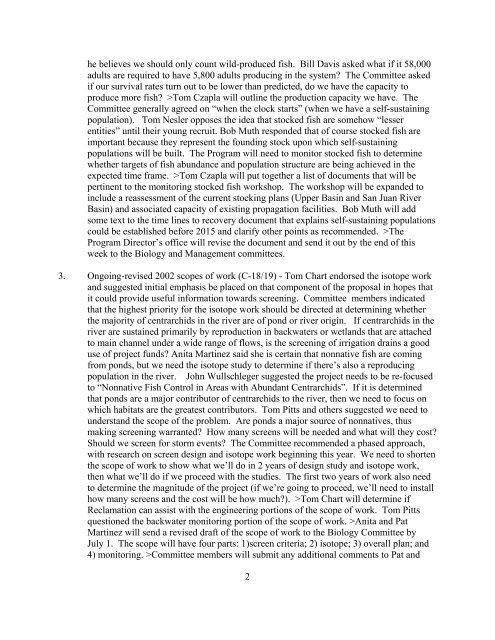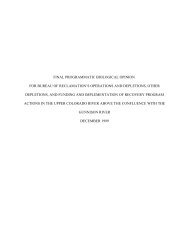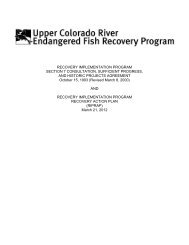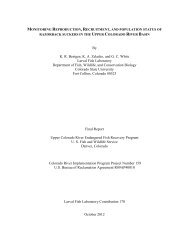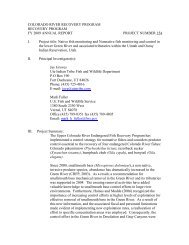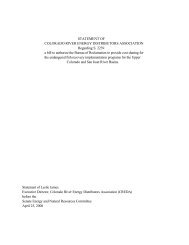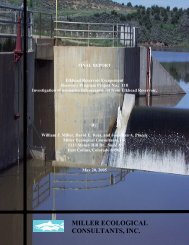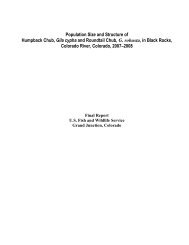18 - Upper Colorado River Endangered Fish Recovery Program
18 - Upper Colorado River Endangered Fish Recovery Program
18 - Upper Colorado River Endangered Fish Recovery Program
Create successful ePaper yourself
Turn your PDF publications into a flip-book with our unique Google optimized e-Paper software.
he believes we should only count wild-produced fish. Bill Davis asked what if it 58,000<br />
adults are required to have 5,800 adults producing in the system The Committee asked<br />
if our survival rates turn out to be lower than predicted, do we have the capacity to<br />
produce more fish >Tom Czapla will outline the production capacity we have. The<br />
Committee generally agreed on “when the clock starts” (when we have a self-sustaining<br />
population). Tom Nesler opposes the idea that stocked fish are somehow “lesser<br />
entities” until their young recruit. Bob Muth responded that of course stocked fish are<br />
important because they represent the founding stock upon which self-sustaining<br />
populations will be built. The <strong>Program</strong> will need to monitor stocked fish to determine<br />
whether targets of fish abundance and population structure are being achieved in the<br />
expected time frame. >Tom Czapla will put together a list of documents that will be<br />
pertinent to the monitoring stocked fish workshop. The workshop will be expanded to<br />
include a reassessment of the current stocking plans (<strong>Upper</strong> Basin and San Juan <strong>River</strong><br />
Basin) and associated capacity of existing propagation facilities. Bob Muth will add<br />
some text to the time lines to recovery document that explains self-sustaining populations<br />
could be established before 2015 and clarify other points as recommended. >The<br />
<strong>Program</strong> Director’s office will revise the document and send it out by the end of this<br />
week to the Biology and Management committees.<br />
3. Ongoing-revised 2002 scopes of work (C-<strong>18</strong>/19) - Tom Chart endorsed the isotope work<br />
and suggested initial emphasis be placed on that component of the proposal in hopes that<br />
it could provide useful information towards screening. Committee members indicated<br />
that the highest priority for the isotope work should be directed at determining whether<br />
the majority of centrarchids in the river are of pond or river origin. If centrarchids in the<br />
river are sustained primarily by reproduction in backwaters or wetlands that are attached<br />
to main channel under a wide range of flows, is the screening of irrigation drains a good<br />
use of project funds Anita Martinez said she is certain that nonnative fish are coming<br />
from ponds, but we need the isotope study to determine if there’s also a reproducing<br />
population in the river. John Wullschleger suggested the project needs to be re-focused<br />
to “Nonnative <strong>Fish</strong> Control in Areas with Abundant Centrarchids”. If it is determined<br />
that ponds are a major contributor of centrarchids to the river, then we need to focus on<br />
which habitats are the greatest contributors. Tom Pitts and others suggested we need to<br />
understand the scope of the problem. Are ponds a major source of nonnatives, thus<br />
making screening warranted How many screens will be needed and what will they cost<br />
Should we screen for storm events The Committee recommended a phased approach,<br />
with research on screen design and isotope work beginning this year. We need to shorten<br />
the scope of work to show what we’ll do in 2 years of design study and isotope work,<br />
then what we’ll do if we proceed with the studies. The first two years of work also need<br />
to determine the magnitude of the project (if we’re going to proceed, we’ll need to install<br />
how many screens and the cost will be how much). >Tom Chart will determine if<br />
Reclamation can assist with the engineering portions of the scope of work. Tom Pitts<br />
questioned the backwater monitoring portion of the scope of work. >Anita and Pat<br />
Martinez will send a revised draft of the scope of work to the Biology Committee by<br />
July 1. The scope will have four parts: 1)screen criteria; 2) isotope; 3) overall plan; and<br />
4) monitoring. >Committee members will submit any additional comments to Pat and<br />
2


